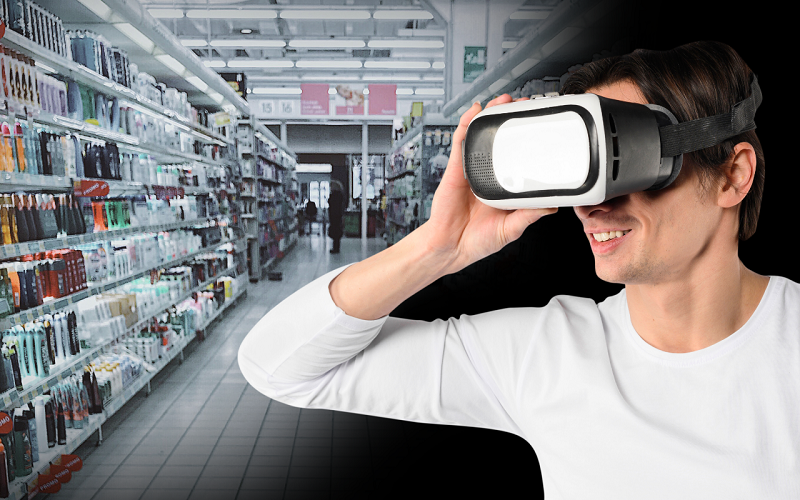Digital transformation is driving industries to evolve to new dimensions. Mixed reality is one of the key components in the digital reality trends that business sectors a rapidly capitalizing into. It is reshaping almost every conventional way that retailers do business. Many industrial trajectories are responding immediately to give more experiential customer experience with reality technologies such as Augmented Reality, Virtual Reality and Mixed Reality. And these innovative technologies are bringing the gap between retail shops and end customers during these difficult times with unique shopping experience.
In this blog let’s discuss what is Mixed Reality and how it transforms retail shopping experience.
What is Mixed Reality for Retailers?
Mixed reality combines the best of both augmented reality and virtual reality and dynamically integrate the real-world into the virtual world. This phenomenal technology provides the retail industry partners a wealth of opportunity to engage the customers with interactive shopping experience. Mixed reality enables the business to recreate natural environment over a virtual space and enable the users to experience it as in real-life.
With VR in place, Mixed Reality recreates a particular real environment on the virtual space and with AR, users can place real-world objects in the virtual space. Combining both the world together, MR gives a dynamic vison for the customers to see the world through a new lens. By rendering the objects with lively animations, MR creates a real-world with the digital prints of objects around us.
However, to experience a Mixed Reality environment, users need to wear a headgear (smart glass). Same as with experiencing virtual reality, MR demands 3D-enabled googles such as Microsoft HoloLens and Oculus to screen the geometry of the environment and create an immersive experience for the users.
Through the gadget’s customers can experience the virtual environments and interact with holograms around them.
What are the Real-life Use Cases of Mixed Reality?
The remarkable feature of Mixed Reality is ability to deliver the best of virtual reality and augmented reality experiences. In Mixed reality, the visualizing objects would be anchored to a point in the real-world that the user can relate it with his environment that gives a real-like experience. Also, MR provides the freedom to visualize any sort of visual assets.
While focusing on retail sales enhancement, Mixed Reality can help with improving range planning which is an important part for retail merchandisers.
Rage planning is an iterative process which involves building appealing planograms. Normally, building and maintaining of planograms with respect to the changing customer behavior is challenge to retailers. It demands lot of in-store resource efforts and cognitive load.
Mixed reality dramatically simplified the process by visualizing the entire data and graphical representation in 3D form and made it accessible to anyone anytime. It also, provides the real-time statistical data about the inventory, warehouse stock to make informed decisions quicker. Today, with the help of Mixed Reality gadgets with computation capability, retailers can assemble and process data and produce the analytical charts for every separate store accessing the database.
This is happening by accessing the product code on the shelves and triggering the holographic data visualization process. By accessing product code a user can have all the detail of stock keeping unit including brand details, category, profit, sales, stock and compare it with the available inventory and requirements.
Hence, the retail store owners can understand the business readiness of the store through visualized tables clearly.
How to Implement Mixed Reality in Retail?
While creating a Mixed Reality experience you have to consider many factors such as distance between the eyes to products/holograms/codes and its placement. Because it should be recognizable and capture by the glass. The system reads the data only if the code/hologram is identifiable and properly accessible and thereby it can reduce the computational time.
In addition, to offer a visually appealing 3D product demonstration without any experience spoiling factors, while creating the solution, the edges of the screens should be blurred enough to avoid the real world coming inside the edges of the screen. If the user can see the border of virtual world and real world, the complete essence of the experience will spoil.
Above that, the real objective of Mixed Reality in retail store is to identify the product, draw the data to prepare the visualization and convey it to the user in an understandable way. For produce these effects in result, there are lot of technical components to workout. Also, retailers need to find the best solution to apply their business logic of interaction.
Fortunately, we have time-tested tools such as Unity3D with comprehensive features and pre-set models to use. Also, with plenty of code libraries and gateways, the real-time processing speed of MR glasses are also reducing systematically.
Bottom Line
Mixed Reality opened a new door to analyze the store and get the information in real-time at a glance. Hence, retailers can have a great level of understanding about the day-to-day business with complete transparency. This allows retailers to have an accurate record of inventory and up-to-date stock requirements. In summary, if utilized effectively, Mixed reality can do some magic in retail industry with enhanced store management experience and customer experience.

